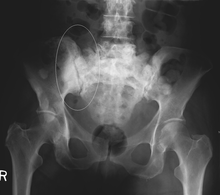- Bone metastasis
-
Bone metastases, or metastatic bone disease, is a class of cancer metastases that results from primary tumor invasion to bone. Bone-originating cancers like osteosarcoma, chondrosarcoma, and Ewing's sarcoma are rare.[1] And, unlike hematological malignancies that originate in the blood and form non-solid tumors, bone metastases generally arise from epithelial tumors and form a solid mass inside the bone. Bone metastases cause severe pain, characterized by a dull, constant ache with periodic spikes of incident pain.[2]
Contents
Sources of Bone Metastases
 Main sites of metastases for some common cancer types, with lung and breast routes to bones shown at shoulder level. Prostate cancer, the third major source,[3] is not shown because of female model. Primary cancers are denoted by "...cancer" and their main metastasis sites are denoted by "...metastases".[4]
Main sites of metastases for some common cancer types, with lung and breast routes to bones shown at shoulder level. Prostate cancer, the third major source,[3] is not shown because of female model. Primary cancers are denoted by "...cancer" and their main metastasis sites are denoted by "...metastases".[4]
Bone is one of the most common locations for metastasis.[5] While any type of cancer is capable of forming metastatic tumors within bone, the microenvironment of the marrow tends to favor particular types of cancer, including prostate, breast, and lung cancers.[3] Particularly in prostate cancer, bone metastases tend to be the only site of metastasis.[2]
Phenotypes
Under normal conditions, bone undergoes a continuous remodeling through osteoclast-mediated bone resorption and osteoblast-mediated bone deposition.[3] These processes are normally tightly regulated within bone to maintain bone structure and calcium homeostasis in the body. Disregulation of these processes by tumor cells leads to either osteoblastic or osteolytic phenotypes.[3] Regardless of the phenotype, though, bone metastases show osteoclast proliferation and hypertrophy.[6]
Symptoms
Bone metastases are a major clinical concern that can cause severe pain, bone fractures, spinal cord compression, hypercalcemia, anemia, spinal instability, decreased mobility, and rapid degradation in the quality of life for patients.[5][7] Patients have described the pain as a dull ache that grows worse over time, with intermittent periods of sharp, jagged pain.[2] Even under controlled pain management, these periods of breakthrough pain can occur rapidly, without warning, several times a day.[8]
- Effects of bone metastasis
- severe pain
- bone fractures
- spinal cord compression
- hypercalcemia
- anemia
- spinal instability
- decreased mobility
Causes of Symptoms
- Acidosis
Acidosis is the increased acidity in a given location, whether it is blood, urine, or tissues. Osteoclasts generate extracellular protons, lowering the pH of the extracellular matrix (ECM) around the osteoclast to approximately 4.5.[9] Nociceptors in the bone trigger a pain response in the brain in response to this acidosis.[10] It is thought that this is the primary source of the dull, chronic pain experienced by patients with bone metastasis.[citation needed]
- Bone Restructuring
The uncoupled regulation of the osteoclasts and osteoblasts leads to malformation of the bone.[2] Malformed bones are unable to withstand the normal mechanical stresses placed on them in day-to-day activity, leading to fractures, spinal compression, and spinal instability. Malformed bones may also mechanically trigger pain receptors both within the bone and in the surrounding tissue.
Treatment
The traditional treatments for cancer are Radiotherapy and chemotherapy, usually in combination with one another. Scientists and pharmaceutical companies are researching drugs to target different types of cancer, including metastatic bone diease.
One treatment that has been considered is bisphosphonates. Bisphosphonates have shown great promise in reducing bone cancer pain, bone destruction, and tumor growth.[11] However, they have exhibited side effect such as the induction of arthralgias and osteonecrosis of the jaw.[12]
Pain Management
The World Health Organization's pain ladder was designed for the management of cancer-associated pain. Other treatments include bisphosphonates, corticosteroids, radiotherapy, and radionucleotides.[2]
See also
References
- ^ http://www.nlm.nih.gov/medlineplus/bonecancer.html
- ^ a b c d e Jimenez-Andrade, J.M., Mantyh, W.G., Bloom, A.P., Ferng, A.S., Geffre, C.P., Mantyh, P.W. 2010. Bone cancer pain. Ann NY Acad Sci 1198:173-181. doi:10.1111/j.1749-6632.2009.05429.x
- ^ a b c d Guise, T. 2010 Examining the Metastatic Niche: Targeting the Microenvironment. Sem. Onc. 37(5): S2-S14. doi:10.1053/j.seminoncol.2010.10.007
- ^ List of included entries and references is found on main image page in Commons: Commons:File:Metastasis sites for common cancers.svg#Summary
- ^ a b Coleman, R. 2006. Clinical features of metastatic bone disease and risk of skeletal morbidity. Clin Cancer Res 12:6243s doi:10.1158/1078-0432.CCR-06-0931
- ^ Halvorson KG, Sevcik MA, Ghilardi JR, Rosol TJ, Mantyh PW. 2006. Similarities and differences in tumor growth, skeletal remodeling and pain in an osteolytic and osteoblastic model of bone cancer. Clin J Pain. 22(7):587-600. doi:10.1097/01.ajp.0000210902.67849.e6
- ^ Mercadante, S. 1997. Malignant bone pain: pathophysiology and treatment. Pain 69(1-2):1-18. doi:10.1016/S0304-3959(96)03267-8
- ^ Zeppetella, G. 2009. Impact and management of breakthrough pain in cancer. Curr Op Supp Pall Care 3(1):1-6 doi:10.1097/SPC.0b013e3283260658
- ^ Teitelbaum SL. 2007. Osteoclasts: what do they do and how do they do it? Am J Pathol. 2007 170(2):427-35. doi:10.2353/ajpath.2007.060834
- ^ Julius, B. and Basbaum, A.I. 2001. Molecular mechanisms of nociception. Nature 413:203-210. doi:10.1038/35093019
- ^ Lipton, A. 2008. Emerging role of bisphosphonates in the clinic—Antitumor activity and prevention of metastasis to bone. Cancer Treat Rev 34(S1): S25-S30. doi:10.1016/j.ctrv.2008.03.008
- ^ Drake, M.T., Clarke, B.L., Khosla, S. 2008. Biophosphonates: mechanism of action and role in clinical practice. Mayo Clin Proc 83:1032-1045. doi:10.4065/83.9.1032
Additional Reading
- Castronovo, A. B. a. V. (1997). "Expression of Bone Matrix Proteins in Human Breast Cancer: Potential Roles in Microcalcifacation Formation and in the Genesis of Bone Metastases." Bull. Cancer 84(1): 17-24.
- Chambers, A. (2001). "The functional and clinical roles of osteopontin in cancer and metastasis. Curr Mol Med. 1(5): 621-32.
- Cheifetz, e. a. S. (2000). "Expression of Bone Sialoprotein and Osteopontin in Breast Cancer Bone Metastasis." Clinical Experimental Metastasis 18(3): 253-60.
- Chung, L. (2007). Prostate Cancer: Biology, Genetics and the New Therapeutics, Humana Press.
Categories:- Skeletal disorders
- Osseous and chondromatous neoplasia
Wikimedia Foundation. 2010.

